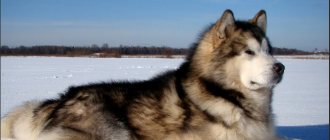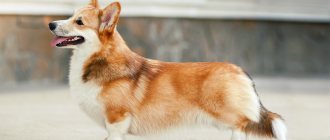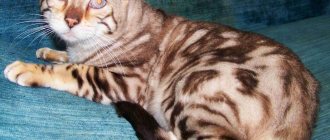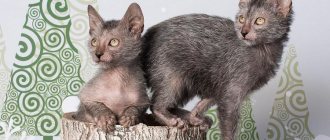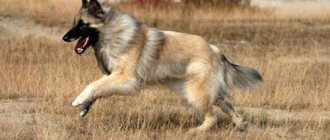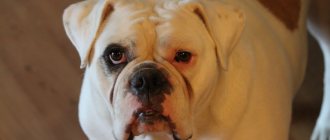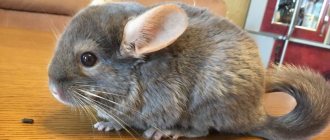The Alaskan Klee Kai is a tiny dog that looks exactly like a miniature husky, but was only developed in the 1970s by crossing huskies with smaller breeds.
Highly energetic and alert, this breed is quite large compared to similarly sized toy dogs. Like many other northern breeds and small dogs, the Alaskan Klee Kai is quite vocal.
These dogs may be suspicious of strangers, but are generally affectionate to their owners. Smart and cautious, they are great at learning tricks and entertaining the family.
History of the breed
The Klee Kai appeared in the United States at the end of the twentieth century. The animals are descended from a union of Siberian and Alaskan huskies. In addition, American Eskimo dogs and Schipperke (a shepherd dog that was bred in Belgium) took part in the creation of the breed. Initially, Linda Spurlin's family was involved in breeding Klee Kais.
In 1988, the breed “went to the people.” Nurseries and private breeders appeared who were engaged in breeding “miniature huskies.” In 1995, Klee Kais were officially approved by the American Rare Breeds Association. In 1997, experts from the American United Kennel Club entered the animal into the registries of their organization.
How to choose a puppy
Klee Kai puppy under mother's protection
First of all, the choice depends on the goals pursued by its future owner. If you plan to breed the breed or participate in exhibitions and competitions, then, without a doubt, you need to look for a puppy in proven and reliable nurseries. In this case, you will be provided with all the necessary documents and certificates. Check that there are no “white spots” in the pedigree.
Responsible breeders ensure the purity of the breed. Puppies that reach eight months of age are tested to ensure they meet the standard. If you want your pet to become a champion at shows in the future, purchase Klee Kai only from specialized nurseries. Do you just want to get a four-legged furry friend who will delight your family? Awards and medals don't interest you? You can try your luck and buy a puppy second-hand from an ad. True, the guarantee of the purity of the breed in this case will be in great doubt, and it is almost impossible to identify non-compliance with the standards in the baby. In addition, it is not a fact that you will get a healthy and strong pet.
It is advisable to choose an Alaskan Klee Kai puppy from a small litter. Pay attention to how he behaves among his relatives in natural conditions, how he communicates or plays with them. Monitor your baby's behavior during feeding. Perhaps the puppy you like will reciprocate and show interest in you as a potential owner. If this happens, do not hesitate to purchase: this will only delay the chance of getting a loyal friend and companion for active games!
Coat and color
The body of the Klee Kai is relatively large, covered with soft and thick hair. Under the hair there is a dense undercoat. A dog's coat usually has the following colors:
- White.
- Black.
- Grey.
- Light brown.
In rare cases, a dog may be completely white. This color option is considered the norm. Klee Kais usually change their coat twice a year. Some owners collect animal hair and sew warm mittens from it.
Klee Kai - character and behavior
Dogs are distinguished by their friendliness and cheerful disposition. They get along well with owners and pets. Some dogs love to “talk” and “sing.” They absolutely cannot stand loneliness and always try to be the center of attention. The Klee Kai has natural intelligence and intelligence. Mini Huskies are easy to train.
You should not leave small children with Klee Kais. If a child pulls the dog's tail or accidentally causes him discomfort, the dog may bite him. The Klee Kai Husky is suspicious of strangers. If a stranger makes sudden movements, the dog may bark loudly or attack the person.
People who are away from home for a long time should not get an animal. The Klee Kai requires constant attention and approval from its owners. Lack of care and affection can lead to the animal becoming withdrawn and unsociable. A Klee Kai can take revenge on its owner for lack of attention. He rips pillows, scratches furniture and chews shoes.
Varieties
Based on their height and weight, Klee Kais are divided into three groups:
| View | Height, cm | Weight, kg |
| Standard | 38–43 | 7,2–10 |
| Miniature | 33–38 | 4,5–6,8 |
| Toy | up to 34 cm | up to 4.1 kg |
Klee Kais are mini huskies. They differ from their “older” brothers by having a high tail and a shorter muzzle.
Advantages and disadvantages
The main advantages of the Klee Kai breed are:
- Silence (dogs rarely bark).
- Resistance to low temperatures (no need to buy special clothing and shoes).
- No allergies to all types of food.
- Unpretentiousness (the dog does not require special conditions of detention).
The disadvantages include the following:
- Puppies have a high price.
- Tendency to escape.
- Some dogs may have problems with socialization and take a long time to get used to their owner.
Diseases and treatment
Hereditary and genetic diseases have not yet been identified, since the breed has a small gene pool. But the breeding program is strict, and most likely, in the future, dogs will be free from the appearance of genetic diseases.
The lifespan of a mini husky is 15-17 years. Considering the small size of the dogs, they can be called long-lived.
Care
Klee-kai are quite neat and clean. It is recommended to comb the dog’s thick fur with a special brush once every 7 days. If he begins to shed, then his hair needs to be combed 2-3 times a week. Once every two months the dog's nails are trimmed. For this purpose it is better to use special forceps.
Your dog's ears and eyes should be examined regularly. They must be cleaned with a piece of clean cloth soaked in warm water. The Klee Kai does not require frequent bathing. Water procedures can be carried out 2-3 times a year.
Peculiarities of diet of Klee Kai
You need to feed your dog after walks and training sessions. Otherwise, the animal may experience intestinal volvulus. The basis of a Kli-kai's diet should be boiled meat and fish. But you can also feed the animal various offal and low-fat kefir.
There is no need to pour milk for the dog. It will cause indigestion and diarrhea. You can periodically cook buckwheat, oatmeal or millet porridge for your animal. You can use dry food to feed your Kli Kai. You can also purchase additional vitamin complexes at the pet store.
Feeding
There are no special requirements in food, as in caring for the Klee Kai. The dogs do not have food allergies, so they are fed natural products and premium food. The diet of small huskies can include lean meat, fish, cereals, and vegetables. Food is served to the dog in small portions up to twice a day.
In autumn and spring, it is advisable to supplement your diet with special vitamin complexes. Puppies eat five times a day. As practice shows, it is better to completely exclude milk from the list of products and add low-fat kefir and cottage cheese.
Expert opinion
Anna Abramenko
An avid dog lover. Experience in veterinary medicine since 2009.
Ask a Question
It is recommended to feed your pet immediately after a walk, this helps improve digestion.
Education and training
Raising a puppy must begin from an early age. The dog must see its owner as a leader to whom it must obey unquestioningly. You should not pamper your Kli Kai and overindulge in all his whims. A spoiled animal will become capricious and aggressive. It will demand from you immediate satisfaction of all its needs.
Klee Kai owners should contact professional instructors who will conduct a general training course with the animals. The dog will master the simplest commands and acquire self-discipline skills. Klee Kais love outdoor play. During walks, the dog should be given plenty of frolic.
Klee Kais love to play with sticks and catch special throwing plates with their teeth. Animals are partial to music, so they can be taught simple “dance” movements. Intense physical activity should be alternated with proper rest and proper nutrition.
You can take your dog with you on your morning jogs. If you ride your bike often, then the Klee Kai can be your exercise companion. There are specially designed obstacle courses for dogs. Completing such a route develops strength, agility and endurance.
Klee Kai have developed intelligence and can remember a large number of commands. Mini Huskies Klee Kai do not tolerate rudeness or shouting. A cruel owner quickly loses the animal's trust.
Nano Husky
2K 5 min.
People are strange animals, always not completely satisfied, and therefore going through life with the question: “Do you have the same one, but with mother-of-pearl buttons?” And even after meeting something or someone completely ideal, we continue to suffer from mother-of-pearl buttons.
Photo: Robert Ashton/Massive Pixels/Alamy/DIOMEDIA
Take the husky, for example - a lovely dog, above all praise, you can’t find fault with it. And still, there was someone who asked: “Do you have the same one, only smaller?” Just a couple of decades ago, someone like that would have been told to go somewhere far away for a small dog, for example, to a Yorkshire terrier kennel. But now you can’t say that anymore, because today we really have the same one, only smaller: under the pressure of circumstances, some huskies have more than halved in size. So from now on they are no longer huskies, but Alaskan Klee Kais. And even though the young breed is not yet recognized by all canine organizations, it is already thriving, because there are surprisingly many people in the world who dream of a husky, but with mother-of-pearl buttons. That is, in miniature.
The Alaskan Klee Kai has a very specific author - an American woman named Linda Sparlin (or even Spurlin). Who didn’t even think about anything like that - until, back in the distant seventies of the last century, she was given a surprisingly small husky: an adult dog weighed only about eight kg, and this despite the fact that the normal weight of a bitch of this breed is kilograms 15–25!
And immediately all Linda’s friends wanted such a little husky. Therefore, when the time came to think about offspring, the owner found the tiniest male available to be her baby’s husband. That's how it all started. And it could easily have ended with a couple of litters and puppies given away to friends, but then the local newspaper wrote about the mini-husky. Linda received a flurry of applications - and from an ordinary American person she gradually turned into the founder and breeder of a new breed of dogs.
Apparently, the matter of breeding Klee Kais was not limited to just selecting the smallest huskies. It is believed that other small dogs took part in the formation of the breed - in particular, Eskimo Spitz, small Belgian Schipperke Shepherds and, possibly, someone else. And now only 10-15 years have passed - and American cynological organizations began to slowly recognize the official existence of Klee-Kai. As for the name of the breed being strange, it’s all very simple: the mysterious “klee-kai” just means “small dog,” but in the Eskimo language.
Outwardly, the Klee Kai really looks like a husky, but there are differences between them. And the most important of them is, naturally, the dimensions. Our little Alaskans are divided into three groups: toy (up to 4.1 kg), mini (up to 6.8 kg), and standard (up to 10 kg). Even the largest of them, belonging to the “standards”, are at least half the size of the original huskies, let alone the toys, which are absolutely pocket-sized.
Another obvious difference is that in a Klee Kai his fluffy tail curls like a donut in a moment of joy, but for a large husky this would be a vice; his tail is always straight, similar to a fox. Klee Kai also have protruding triangular ears, a clear mask on their face, cheerful expressive eyes and an abyss of charm - well, in this they are very similar to huskies.
The coat of the Alaskan Klee Kai has the right to be both shorter and longer - but not so much longer that a nice dog silhouette is hidden behind the excess fluffiness. The main colors are black and white, gray and white and red, that is, red-brown and white. However, they are also allowed to be simply white, but with reservations: most likely, a snow-white Kli-kai will not be allowed to breed due to some genetic reasons that are obscure to a normal person.
What about the eyes, the famous blue eyes of the husky? Yes, Klee Kais also have blue ones. But not all huskies have blue eyes—the same can be said about Klee Kais. However, they are even very good with brown eyes. And with other options inherited from their ancestors - like huskies, Klee Kais can be harlequins (this is when the eyes are of different colors) or “split” (this is when the eye consists of multi-colored pieces).
There is one more difference between huskies and Klee Kais, one might say, a software one: huskies are working dogs, sled dogs, but Klee Kais are pure companions, albeit very athletic ones. That is, they are happy to run and engage in various dog sports, Klee Kais are nimble, passionate, smart, enterprising and easy to train. Theoretically, those who are larger can be harnessed to a sled, unless, of course, the passenger has not yet left preschool age. Well, in moments free from outdoor games, the Klee Kai will pretend to be a cute kitty - this young breed is known for its tenderness, affection, gullibility and need for affection and attention. It is clear that she loves her owners: any normal dog loves her owners. But the Klee Kai is ready to love even strangers, though not immediately: at first, the strangers are only rewarded with a suspicious look, but if the Klee Kai sees that the owners are happy with these strangers, the hospitable mini-husky will be happy with them.
Klee-kai is an amazing creature not only in appearance: he sometimes behaves somehow not quite like a dog. For example, most representatives of this breed love to wash themselves like a cat - that is, such a small top sits and with all imaginable diligence scrubs its face with the help of its front paws, and everyone around weeps with emotion. And the dog also purrs. It doesn’t purr quite like that, but it makes sounds that are not at all dog-like: it grunts, howls, gurgles, moans, sings, and sometimes even says “mom.” Klee-kai are very talkative dogs, but they do not bark often; barking for them is an expression of aggression. Yes, they can be very cocky, so they certainly need to be taught decent behavior from a young age and generally socialized in every possible way. That is, training a baby Klee Kai must be approached with the same responsibility as training a serious, oversized dog. However, Klee Kai is smart and flexible, so he learns quite quickly. And in the end, he becomes the ideal companion: sweet, obedient, loving, giving up the idea of biting, gentle with children, friendly to his own and even neighbor’s dogs and cats - and so on.
Klee-kai are extremely smart and enterprising, and idleness is harmful to them. Or rather, it can be harmful to you - if such a dog gets bored alone, it is quite capable of destroying your apartment no worse than its large prototype. Therefore, this dog must certainly be tired from all sorts of games and walks, and it wouldn’t hurt to provide him with a good supply of toys either. He is also famous as the world's greatest digger! Of course, your flower beds and other landscapes will be in trouble, but that’s not so bad. The trouble is that a Klee Kai can dig under the fence: a typical Klee Kai is obsessed with the idea of escaping. This means that, just in case, it is better to walk him on a leash, and if you let him run around the site, then the fence will have to be deepened, strengthened and constantly monitor the perimeter.
But there are no other hassles with Kli Kai. He doesn't need winter clothes - he doesn't freeze even in arctic frosts. He lives for a long time, 15-17 years, he is so unpretentious in food that he can be considered an omnivore - most Klee Kais will eat even a tenderloin or a boiled carrot with equal enthusiasm, just come on. However, this does not mean that you can feed him anything; after all, a dog is not a garbage dump for you.
He also does not suffer from breed diseases, requires brushing no more than once a week and never needs to be cut, except perhaps to trim the fur between his toes. He sheds very moderately, and practically does not smell like a dog - they say that even allergy sufferers can get this breed, but just in case, you should first lock the allergy sufferer with a Klee Kai in the same closet and see what happens. And he (the dog, not the allergy sufferer) doesn’t need to be washed - unless you freshen him up a couple of times a year, and even then it’s not necessary: the classic Klee Kai is a famous neat guy. He will do everything possible to avoid stepping in the mud, will try to avoid all puddles, and besides, he will not at all strive to roll in something rotten, long dead or simply smelly.
The main problem with Klee Kais is that they are not so easy to buy. And not because of their price, although mini-husky puppies can cost anywhere from two to six thousand dollars, or even more. The dog is rare! And therefore, calling the nursery in the morning and setting up a nest for the cutest of the puppies in the evening almost never happens with Klicks: potential parents have not yet thought about anything like that, and there is already a line lined up for their imaginary puppies. So you usually have to wait several months for a personal Kli-kai. But believe me - it's worth it!
Health, life expectancy and vaccinations
The dog is distinguished by good health and the absence of genetic diseases. Acquired pathologies include:
- Dislocation of the kneecap.
- Hernia.
- Cystitis.
- Stomach upset.
- Cardiovascular failure.
- Liver and thyroid dysfunction.
Puppies need vaccinations every year. Vaccination is carried out using complex preparations. The first vaccination is given to a puppy at the age of 1 to 3 months. 15 months after the second vaccination, the animal’s body becomes immune to severe infectious diseases.
Some Klee Kais suffer from worm infestations. In this case, the dog needs to be shown to a veterinarian, who will prescribe a course of antiparasitic drugs. With proper care and feeding, the Alaskan Klee Kai can live up to sixteen years.
Appearance and photo
The dogs have a strong, but not massive build. Flat back, wide croup, well developed chest. The length of the body and the height of the withers differ slightly in size. Miniature Huskies have straight paws and strong, flexible pasterns. The preferred tail shape is a ring, single or double.
The head should be proportional to the body. The transition from forehead to muzzle is not very noticeable. The muzzle tapers slightly towards the nose. His preferred color is black. A pink stripe is acceptable. In light-colored dogs, a brown lobe is not considered a fault.
The Alaskan Klee Kai has high-set ears and small almond-shaped eyes. Roundness is not considered a fault, but is little valued. Their color can be any. Disagreement is allowed.
The most important feature that distinguishes Klee Kai from a husky is a special mask on the face, pronounced and contrastingly colored. Unlike the Alaskan Husky, the Klee Kai is a very energetic, fast, incredibly active, very curious and playful dog.
How much does an Alaskan Klee Kai cost?
There are several nurseries in the Russian Federation that breed Alaskan Klee Kais. The cost of a puppy is from 120 to 350 thousand rubles. Many Russians order Klee Kais from America. In this case, the price of the animal increases due to transport costs, customs duties and telephone conversations.
The owners of Russian nurseries do not sell puppies to everyone. At the first stage, a potential buyer needs to undergo an interview and fill out a questionnaire. Breeders may refuse to purchase a Klee Kai without giving any reason.
The contract for the sale and purchase of an animal contains clauses obliging the dog owner to maintain constant contact with the owners of the kennel. All these measures are aimed at preserving the purity of the breed, the representatives of which are under strict control of the American cynological associations.
Mating
Breeding Klee Kais is a big headache for owners. Finding a partner is difficult, because the breed is very small and young. In addition, there are discrepancies in the standards of various cynological associations. There are certain difficulties in identifying defects in the breed. Some unscrupulous breeders overlook little things that can lead to defects in puppies. If you decide to breed your pet, try to find a good nursery. It is best if you have the opportunity to travel with him to the historical homeland of the breed. In Wasilla, you will undoubtedly find a worthy partner, but is the joy of owning little Klee Kai worth the costs that you will have to incur to breed the animal. In any case, before breeding a dog, it is necessary to deworm it and ensure its normal physical condition. The mating procedure itself is carried out, as a rule, in the territory of the male dog. This should be done when the third heat occurs.
Important! For a rare and expensive breed, the presence of a breeding specialist is mandatory. Take care of this in advance.
Interesting Facts
- Huskies Klee Kai can jump high. They can easily jump over a high fence.
- The dog loves to dig in the ground. If the fence is at a shallow depth, the dog can escape.
- In the Eskimo language, the phrase Klee-Kai means “small dog.”
- The animal periodically washes its face with its front paws. Representatives of the cat family do the same.
- Klee-kai communicate with each other and their owner using a specific language. It consists of a set of slurping, gurgling and howling sounds. Some dogs can parody human speech.
- The body and fur of the animal do not smell like a dog.
